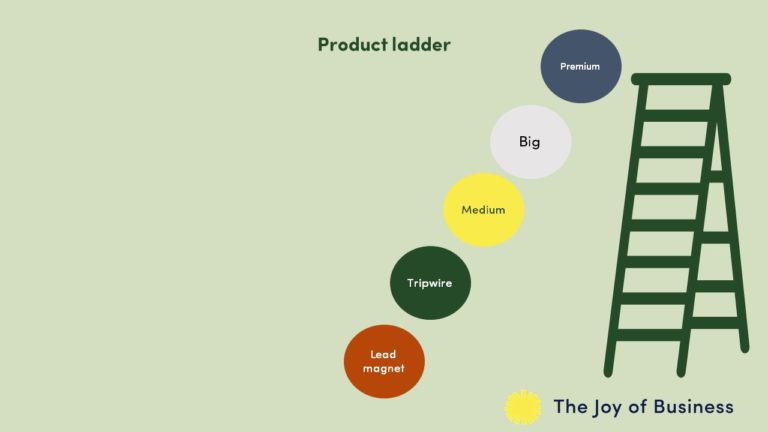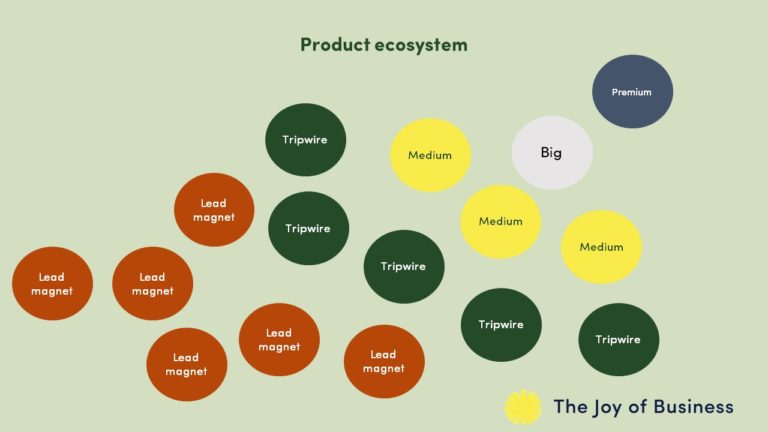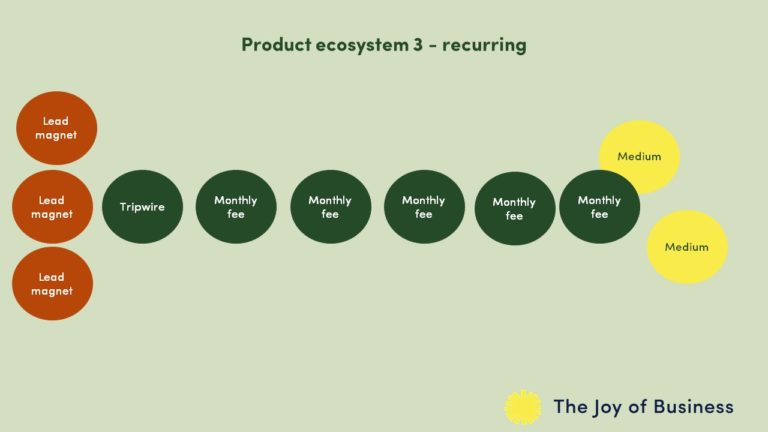Definition: A product ecosystem is a group of products that work together. They’re all related to some degree, but they’re different in how they serve your customers.
I’ve spent hundreds of hours reading, researching and reverse engineering successful products businesses. And I’ve worked with dozens of clients who have productised what they do. I’ve concluded that thinking about your products as part of an ecosystem right from the get-go contributes enormously to your earnings potential.
Whether you’re concentrating on productised services, stand-alone products or a mix of the two, having multiple offerings that are all in the same ecosystem makes sense.
Why I think product ecosystems are vital
Your ecosystem of products means that you can help clients at the right level. Planning the components of your ecosystem from the beginning keeps you away from the classic mistake of trying to build your signature product first. With an ecosystem mindset, you can make your products in a modular fashion and:
- reuse your content in different formats
- add extra parts for the more complex products
- cut sections out and simplify them for use in the less expensive products.
And most of all, developing your product ecosystem hugely increases your customer lifetime value.
Having several different products makes your customers more likely to buy from you repeatedly over time. Way more satisfying for you – because you know that you’re actively helping people when you can see them coming back for more. And you make more money and increase the long-term prospects for your business.
What we mean by product ecosystem
A forest isn’t just an assortment of trees: it’s all kinds of organisms working together. Your product ecosystem is similar to a natural ecosystem like a forest. Maybe a grand old oak tree in the centre with beech trees around it. Underground, a vast network of fungi shares nutrients between the trees. Squirrels live in the trees and eat their seeds; stag beetles burrow into the leaves shed by the trees, bats live in the holes in the older trees pecked out by woodpeckers, and all these animals provide nutrients for the trees in return. Each part is independent, but they all work together and support each other.
Your products are like this forest.
Each one can be appreciated (and purchased) in its own right, and they work better together, reinforcing. One product creates the right conditions for someone to buy another. All of them are part of your online presence, website and other channels, such as the emails you send to people who sign up to get your first products your lead magnets.
The different kinds of products in an ecosystem

You can see your products along a line of increasing size, complexity and price, and divide them into different types of product such as:
- Lead magnets – useful freebies to start engaging with new potential people.
- Tripwires – low priced tools and guides where people will often make their first purchase from you, knowing that they can check you out for a small, virtually risk-free sum.
- Medium-sized products -– usually the ones you want to sell the most of.
- Big products and Premium products – a crucial part of your pricing
Read – the most profitable different types of digital product
But that’s not a product ecosystem
Dividing your products this way gets you started, but it’s not in itself an ecosystem: it’s just a list separated by size and price. It doesn’t show the relationship between the products, and it doesn’t help us think about them from the customers’ point of view. And we’re always trying to see our products through our customers’ eyes – they’re the essential people in this relationship.
How the products in your ecosystem are interrelated
All of the products in your ecosystem need to be related to one another through
- Your “magic”- the secret sauce behind how you uniquely help your clients. It might be a methodology you’ve come up with over the years, an aspect of your in-depth knowledge or a unique way of seeing what you do. (If you feel that you don’t have any magic or unique big ideas, don’t worry; we go into depth on this in our Pivot to Products and Productise Your Expertise courses, helping you drill down and find that big idea. Everyone has one in them, but it can sometimes take a bit of work to excavate.)
- All the products are for roughly the same group of people, who all have a particular problem you can solve for them through your products. Some of these people might have different budgets, but they will all share that problem.
Product ladders and value ladders

You might have come across the idea of the product ladder or value ladder. I have some reservations about this way of thinking, as you’ll see in a moment, but it can be helpful. We can see how a customer might go up the value ladder, first checking you out through some of your free or low-value products – the lead magnets and tripwires they find helpful – then buying something more substantial in the future.
I see this all the time. Someone buys a tripwire e-book or tool, and then that person’s name pops up again later when they buy a course.
But not every client starts at the bottom of the ladder. Humans behave in all kinds of ways. I’ve bought $1,500 courses just because I needed to learn certain things, and I’d had a timely email from them saying, “Hey, we’ve got this cool course.” I didn’t buy a certain number of smaller products first, working my way up the ladder.
The crucial factor for someone buying a medium or big product is trust
Do they trust you to solve their problem?
Trust doesn’t just come when customers experience your products at the bottom of the value ladder. Every possible interaction with your potential customers needs to be about building their trust in you.
When it comes to selling premium products, I have more reservations about the value ladder. When you charge more than 5k for something, you can’t just depend on your ladder to build the necessary trust. You probably need that extra bit of trust-building that comes from enabling them to meet you, at least on Zoom.
The linear value ladder approach is too simplistic and can lead you astray. I believe it’s much more helpful to get your head around the alternative idea of having a product ecosystem.
Product ecosystems in action
The product ecosystem approach gives you a much more nuanced and flexible way of working out what kinds of products you want to make. And how you can encourage people to buy more than one – and buy the ones that will earn you good money.
Let’s take a look at some of the possible product ecosystems you might use.
Your basic product ecosystem

This example is fairly typical. You’ve got a bunch of lead magnets to draw traffic to you and encourage people to give you permission to start sending them emails. Then you have some tripwire products to generate a pleasant background hum of tiny Stripe payment notifications, bringing you small amounts of cash.
Then there are a few medium products, maybe a bigger one and a premium one. You can see how this is much more nuanced and flexible than the value ladder idea.
Don’t worry if you look at this and think, “Oh my god, Julia, how many products do you think I can make?” You don’t need all of them at the beginning. Start with a couple of lead magnets – but with the ecosystem image in mind. Otherwise, there’s the danger that you’ll create unrelated lead magnets and bring in a bunch of people who were interested in your freebie but would never be into buying your medium products.
While you’re creating these lead magnets, you’ll be delightfully challenged by the need to explain your complex knowledge to other people. Concentrating on the lead magnets and tripwire products first, before you tackle the more extensive products, enables you to start building your audience, your tribe of fans. And it allows you to develop your thinking about your specialist area.
Your ecosystem is not just the products themselves. When someone grabs a lead magnet, they’re giving the thumbs up for you to send them more helpful insights, so you can regularly send emails imbued with your brand personality. You can open a dialogue with them about the different aspects of how you solve that central problem for clients. And maybe send a smattering of invitations for them to engage with you through surveys, quizzes or just by hitting reply. That builds trust, so when you’re ready to promote your more pricey products, your tribe is happy to buy. Well, some of them anyway.
An ecosystem for an audience with smaller budgets
You’ll see that this product ecosystem has a lot more tripwire products and no premium. You could easily make a good living from this – a collection of low-priced tripwires and one medium product. In Productise Your Expertise, we reverse engineer some of the brands that work this way to learn from them.

This setup can be an excellent place to start because all the time you’re selling those tripwire products, you’re building your relationships with your tribe through your follow-up emails.
If your audience has a small budget, you can still help them through your products without charging a huge fee for each one. But this approach needn’t just be for people who don’t have much money to spare. You can use this model because you enjoy making tripwires. Some people spend most of their time on a productised service and then devote Fridays to inventing tripwires that bring in some extra cash and more potential clients.
The recurring income product ecosystem
The recurring income product ecosystem has a few lead magnets to draw people in and maybe a tripwire or two to encourage initial purchases. But the primary offering is a membership or subscription with a monthly fee. This fee might be for continued access to a library of resources or a new piece of content your members get every month.

The fee might be monthly or annual. You probably already have subscriptions to Software as a Service products like this if you’re hosting your video with Vimeo, keeping your books with Xero accounting or enjoying your snacks by post every month from Graze.
You can see why I love this product ecosystem so much. Regular cashflow is every entrepreneur’s dream. Once you’ve brought a customer in, and as long as you continue to solve their problem, they automatically send you money each month.
And, of course, you can have multiple recurring income products all working together and add in some medium products to increase customer lifetime value.
Anchor your prices through your premium products
Premium products include more intensive courses, mastermind groups, and productised services like personalised reports or in-depth assessments.
Your premium products might incorporate a substantial chunk of you. They might be a course with a live teaching element or coaching support included, or even a “done for you” version where you have a limited number of slots to do the implementation work for clients. Ironically, this last one is often very similar to the services you used to offer when you only provided bespoke services. The change is that your premium “done for you” service now has a very different price tag because of all the marketing you’ve been doing to promote the other products.
These are the kinds of products you’d love more people to buy because they have a higher price and there’s more money to be made. You might also love to create and sell these products because you get to go deep into your subject and spend a lot of time building something brilliant. And when you have personal involvement, you can also see first-hand the impact you’re having for clients.
Sometimes, when you’re at the starting stages of planning and creating your product ecosystem, it isn’t easy to see what the big and premium offerings might be. Or you might have a vague idea but not be anywhere near ready to work on these products yet. That can be a wise decision, keeping these back until you’ve honed your skills on some of the smaller products first.
But it can be helpful to include these more in-depth products visibly in your list of products, even if the sales page is very vague and its only call to action is a button that says “join the waiting list”.
Two reasons for including higher-value products
You might get people who want that higher-end product and want to join your waiting list, which will give you some valuable information about demand.
Including the premium products shows a more expensive option for anyone considering a medium product. The more expensive option acts as a price anchor for the other products, effectively making them look very reasonably priced in comparison. Customers then hesitate less about getting their wallets out and buying your medium products.
Upsells
We’ve talked about how humans don’t necessarily jump up the next rung of your value ladder and that it’s helpful to think in terms of a more complex product ecosystem instead. But there is one area within the ecosystem where you can encourage people to make a little jump, and that’s with upsells.
I once tried on some clothes at Hobbs and walked out with some rather beautiful but unsuitable boots as well as the new dresses I’d picked out because the salesperson brought the boots into the changing room. I’d been upsold a £200 pair of boots
Within your ecosystem, you can work out what goes with what. If one of your medium products is a benchmarking report, you might upsell your client an annual subscription to all future reports. With a mastermind programme, you might sell a continuation of the programme for a lower monthly fee at the end of the initial programme.
When someone is in the process of buying one thing from you, they’re open to purchasing something else, either at the same time or very soon after their initial purchase. I did precisely this last week when I bought a book about minimum viable product shipping techniques from someone. It was a useful resource, and two days later bought another book from them. In my case, I did this entirely voluntarily: I went back to their website and bought something else in my warm glow of positive experience from the first book.
If I was that company, I could have taken a leaf out of the ASOS playbook and sent me a friendly email straight away suggesting other products I might buy. ASOS have studied this in-depth with all their millions of purchasers. They discovered that people are most likely to buy again from them within six weeks of their initial purchase. If you ever buy anything from ASOS, you’ll get a whole stream of emails from them in that six-week window, suggesting all kinds of other purchases.
The true genius of the product ecosystem approach
Now the product ecosystem approach gets clever. You can add upsells and downsells (where you offer a less expensive alternative product to people who haven’t bought your medium product) and encourage people to move around the product ecosystem until they find something right for them. And encourage them to come back.
At this point, the product ecosystem starts giving you and your customers a lot more choices. This video (a free sample of one of the course videos from Productise Your Expertise) takes you through some real-life examples of product ecosystems.
Decide on your priority products
To seed your product ecosystem, I suggest starting with your initial list of product ideas, brainstorming a whole lot more and then choosing a shortlist of the ones you’re initially committing to work on, using the Priority Product Decision Maker. We work on this process as a group in Module 7 of the Productise Your Expertise programme.
Then start to work out how these might fit together as an ecosystem.
But just because, one day, you planned your product ecosystem to look a certain way doesn’t mean you have to stick to that plan. You might find that a particular product in your niche area becomes super popular, and you want to reframe everything to concentrate on that niche area. Maybe someone else will ask you to resell their product for them, and there’s a simple addition to your ecosystem and profits right there. Or you might come up with a fantastic new product idea six months from now and include that in your ecosystem.
These are all great ways for your product ecosystem to evolve and mature.
How product ecosystems change over time
It’s worth being mindful of the way ecosystems can potentially change, especially if you’re like me and tend to stick to the plan once you’ve made it. But bear in mind
No Plan Survives First Contact With the Enemy
Helmuth von Moltke
You might want to retire or hide some of your products after a couple of years. Either they don’t sell that well, they become out of date, or you prefer that people buy something else. When you’ve made a tripwire version first and then dug deeper to create a more in-depth product: you might find that the tripwire cannibalises sales for the big one. Or maybe you end up with such a massive list of products that your prospective customers find it challenging to decide what to buy … and end up going away with nothing.
You might be able to recycle some of your content from one product to another. In Productise Your Expertise, there are some great techniques for rapid product development using modular content.
Paddy Gilmore’s product ecosystem
Paddy credits the Pivot to Products course as where he learnt how to put together his own product ecosystem.
As you change and gain new skills
When we first make products, we tend to use the format that we’re most comfortable with. For me, that’s writing, so my first product was a book. I now know better, and question whether it was worth it to write a book, especially as my first product. And I had a block about making videos. But after a while, I started doing more video content, and now that’s a significant part of my products because it’s better for my audience. You might find that you have a similar journey, going from one medium to another, developing new skills, and finding new ways to communicate. And being of more use for your tribe.
This is what making products is all about

